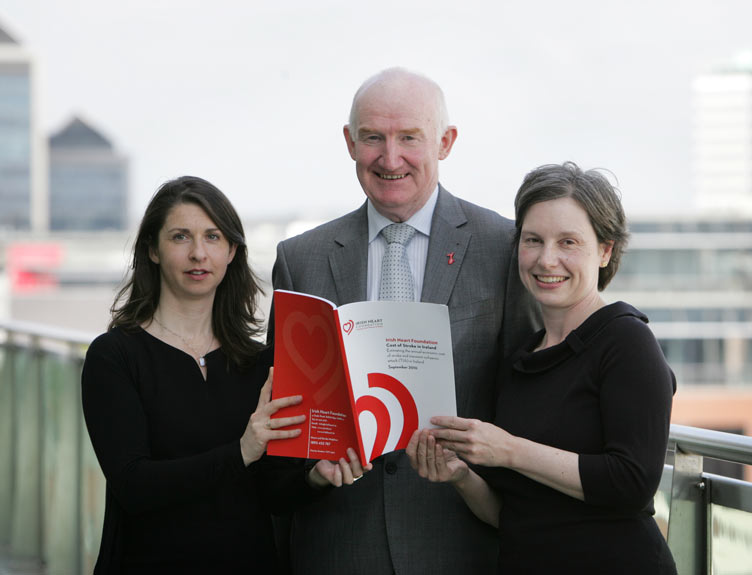750 more stroke victims could be saved each year

An extra 750 stroke victims could be saved from death or lifelong dependency each year by acute service improvements that would actually save the taxpayer money, a major new report for the Irish Heart Foundation has revealed.
The report, Cost of Stroke in Ireland (COSI), compiled by the Economic and Social Research Institute (ESRI) and RCSI with the help of some of Ireland’s foremost stroke care experts reveals that the overall annual bill for stroke in Ireland could now exceed €1 billion.
The report was commissioned by the Irish Heart Foundation and led by Professor Miriam Wiley and Dr Samantha Smith from the ESRI. Members of the COSI research team from RCSI included Dr Frances Horgan (Physiotherapy), Dr Anne Hickey (Psychology) and Dr Emer Shelley (Epidemiology).
“This report represents the most comprehensive research ever carried out in Ireland on the baseline economic burden of stroke and the potential cost benefits of key medical interventions,” said Dr Frances Horgan, Chairperson of the Irish Heart Foundation Council on Stroke and Senior Lecturer in Physiotherapy at RCSI.
The current cost of stroke in Ireland could be slashed by up to €13 million a year if there was general access to stroke unit care and assessment for the clot-busting treatment thrombolysis.
The price tag for providing these key interventions would be more than offset by savings accruing from improved patient outcomes – particularly from reduced demand for nursing home care which the research found accounts for a staggering 40% of the overall cost of stroke in Ireland.
Irish Heart Foundation Chief Executive Michael O’Shea said that nobody disputes the huge scale of avoidable death and institutionalisation caused by the inadequacies in acute, rehabilitation and support services for stroke patients across Ireland.
Mr O’Shea said: “The reason these deficits still exist is due to uncertainty over the cost implications of delivering high quality stroke services, particularly in the face of the current economic realities. This report addresses that concern because even if you take the most pessimistic view of the data, we can still have world-class acute services saving hundreds of lives and saving millions of euros each year.
“Of course, the Government receives many reports claiming that upgraded services will result in cost reductions at some stage in the future. The difference in this case is that better stroke services will lead to almost instant cost savings because increased access to stroke units and thrombolysis will result in immediate improvements in outcomes and therefore lower demand for nursing home places.”
The report also illustrates the serious consequences that will face the country if we fail to take decisive action now – including a 50% increase in stroke incidence and a 50% increase in the overall cost of the disease to the economy by 2021 because of the ageing population.
And it reveals a pitiful absence of vital rehabilitation services desperately required by many of the country’s 30,000 stroke survivors. Less than €7 million a year is being spent on community rehabilitation for stroke survivors – an average spend of just over €200 per person on what are often highly complex therapy needs. The Irish Heart Foundation believes it is vital that a full cost-effectiveness analysis of these services must also now be urgently carried out.
According to the Irish Heart Foundation, ring-fenced funding should now be allocated to achieve these savings through the HSE’s National Stroke Strategy headed by lead physicians Prof Peter Kelly and Dr Joe Harbison. At the recent launch of the Cardiovascular Health Policy, which sets out a blueprint that would make Irish stroke services comparable to the best in the world, Minister Harney said there could be no extra funding for service improvements. And whilst the HSE’s National Stroke Strategy is making some headway, there is no dedicated funding stream.
The report findings include:
- 95% access to stroke unit care would result in up to 650 stroke victims being saved each year from death or dependency at a potential annual saving of 10 million. Achieving a 20% rate of thrombolysis could also save 100 people from death or dependency annually at a saving of up to 3 million a year. Even at the lowest end of the scale, the net result from these service improvements would be over 200 extra people saved each year from death and dependency and savings of over 3.5 million.
- The total cost of stroke in Ireland is up to €1,004 million – direct costs alone equate to more than 4% of the annual health expenditure. Nursing home accommodation accounts for around 40% of the total cost.
- Factors such as our ageing population may result in the number of stroke cases in Ireland increasing by more than 50% by 2021. This would result in an increase of at least 50% in the overall cost of stroke to the economy.
- The baseline estimate of the cost of community rehabilitation for stroke patients in 2007 was less.
than €7 million. - The mean direct cost per stroke patient in the first year of stroke is €18,751.
The COSI research team also included Professor Hannah McGee, Professor Seamus Cowman, Professor David Whitford, Professor Ronan Conroy and Ms Maeve Royston from RCSI.



